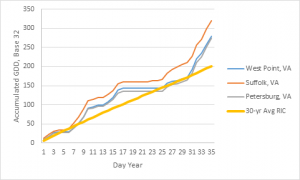Previous work in VA has demonstrated that we “normally” accumulate around 1350 GDD from planting to jointing in wheat in Virginia. The warm weather this year has been anything but normal and so I don’t think we can follow that guidepost this time.
Our wheat varieties require at least 30 days of temps less than about 42 degrees to vernalize. In most areas we made that threshold of at least 30 days between what I considered to be a normal planting date for the region and the end of the year. For example near Richmond a crop with planting date of Oct 20 would have experienced 31 days with lows below 42F before January 1. Other researchers have reported that wheat requires around 700 GDD after the vernalization threshold has been reached. This seems pretty reasonable for use in VA. When comparing to the 30 year average temperatures for central VA, 700 GDD accumulated from January 1 predicts a jointing date of March 20. I believe this matches well with historical observations for the crop
Below is a figure showing GDD accumulated at 3 sites in eastern VA since January 1, 2016.
Yep – it’s been warm. About 40% greater GDD accumulation at this point in the year compared to the long term average. Normally we are accumulating about 5.75 GDD/day this time year. This year it’s over 8.
I honestly don’t what this means for us in terms of wheat development.
If the temperatures return to the 30 year average tomorrow the warm weather thus far would have relatively little impact. Instead of predicting a jointing date of March 20 (700 GDD) we would get to 700 GDD on about March 15.
The 14-day forecast I’m looking at has us continuing to stay warmer, however.
If we stay near the current trend through jointing, it’s possible we will be 3 weeks ahead of the long term average.
I won’t pretend to be able to forecast the coming weather, but I think it’s likely that things may begin to happen very quickly with the crop.
This may impact our ability to split N applications as driving over wheat that’s already jointed damages the growing point. I suspect weeds, insects, and disease are also responding to these warmer temperatures. Small weeds are going to get to be big weeds sooner this year. Diseases like powdery mildew have already been found in the crop in some places. Scouting early and often may prove a valuable investment.

